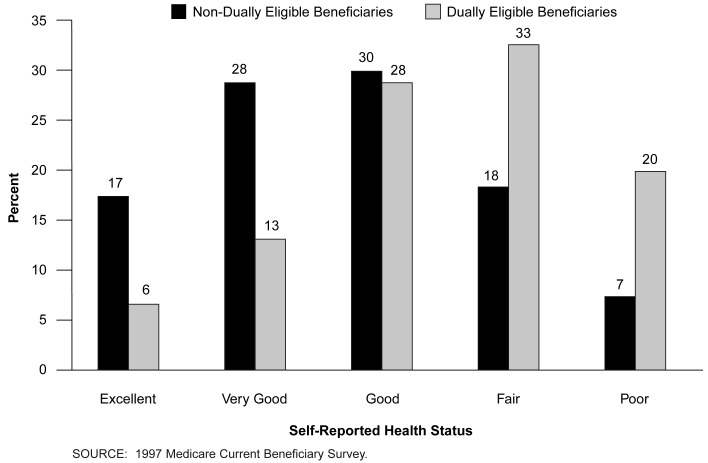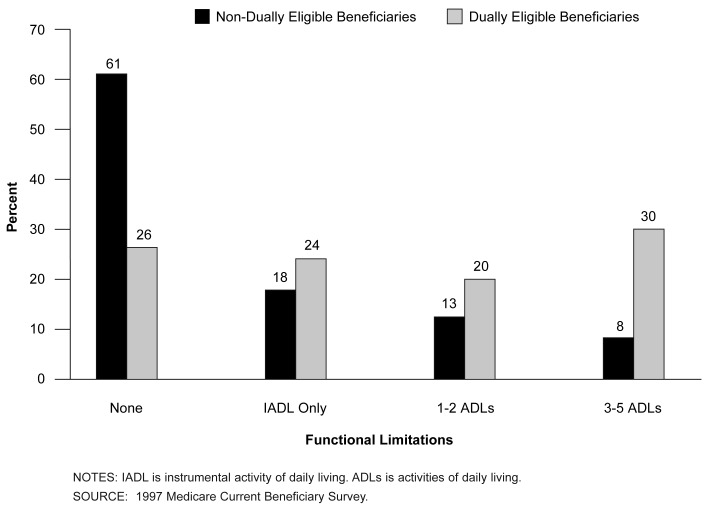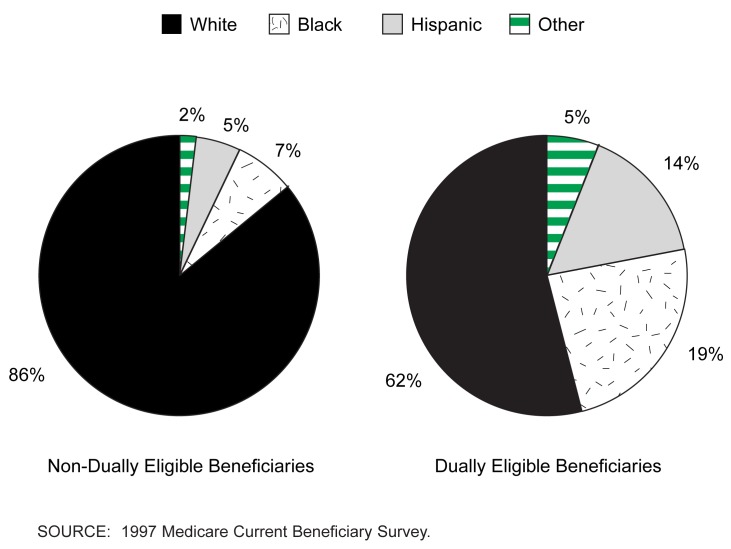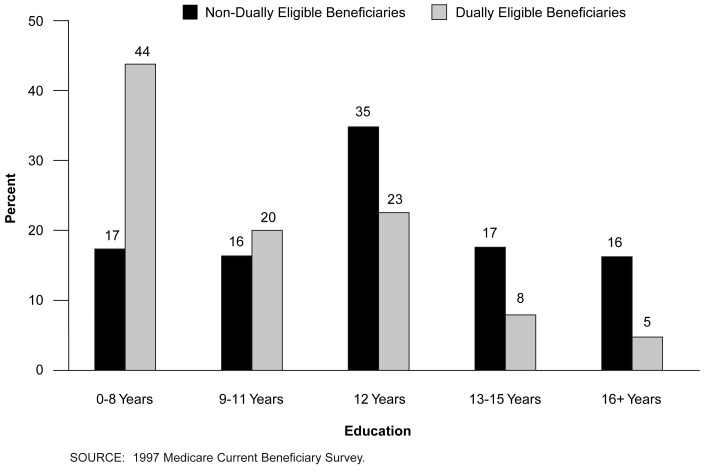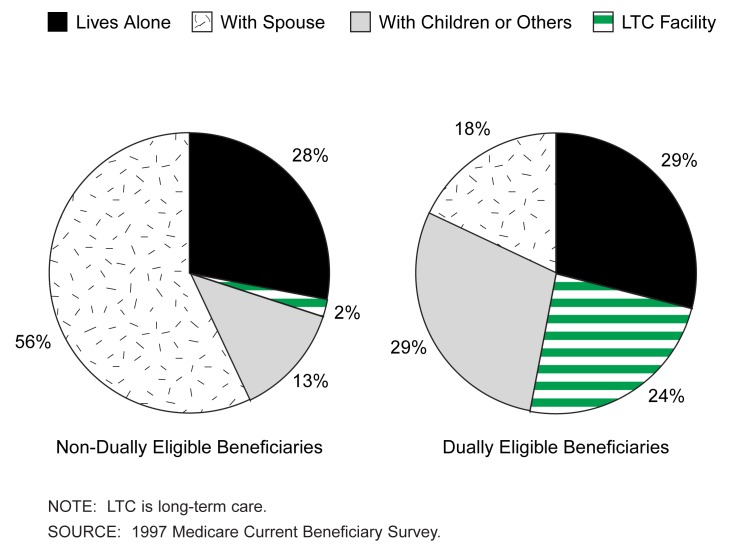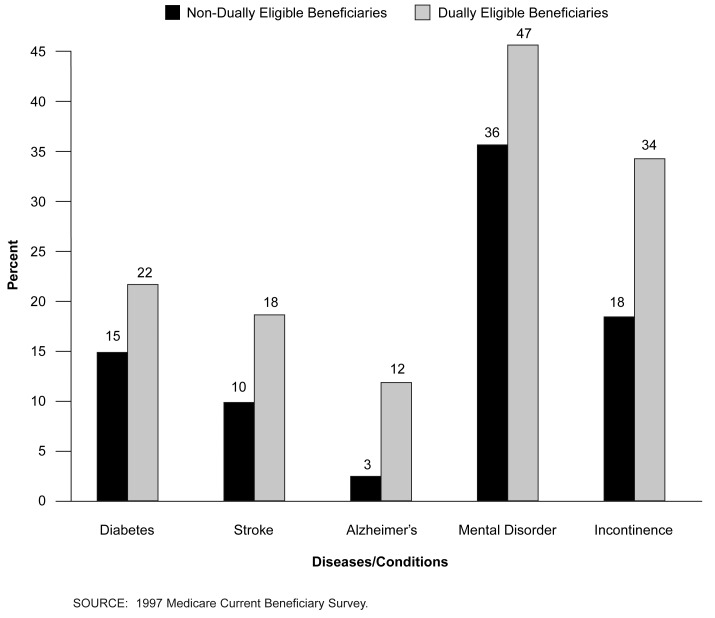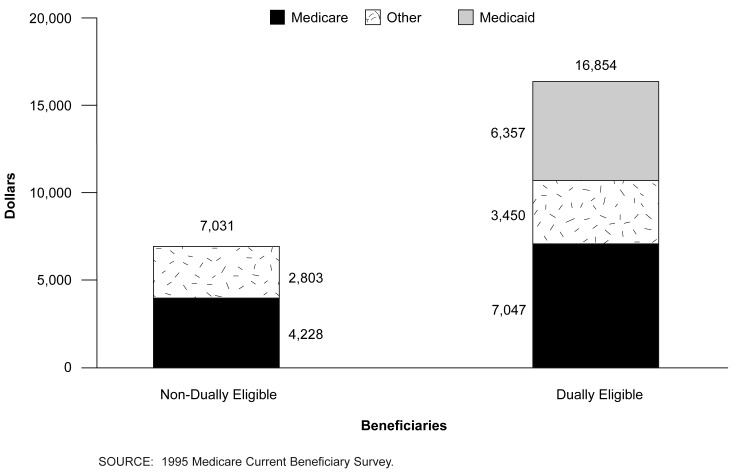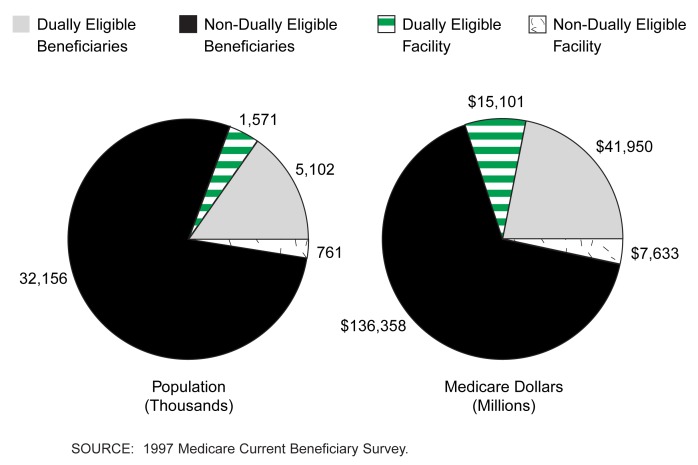The Medicare Current Beneficiary Survey (MCBS) is a powerful tool for analyzing the Medicare population. Based on a stratified random sample, we can derive information about the health care use, expenditure, and financing of Medicare's 37 million enrollees. We can also learn about those enrollees' health status, living arrangements, and access to and satisfaction with care. The MCBS allows for detailed analysis of the dually eligible population. The 1997 sample of dually eligible beneficiaries totaled about 3,500 respondents. In addition to Medicare expenditures the MCBS collects data on health expenditures paid for by Medicaid, by others, and by the beneficiaries themselves. Demographic data, and information on living arrangements, and health conditions are also collected. All of this information can be combined to offer a more complete profile of the dually eligible population than would be possible from Medicare administrative data alone.
Figure 1. Percent of Beneficiaries Living in the Community and in Nursing Facilities: 1997.
- Nearly one-quarter of dually eligible beneficiaries live in nursing facilities.
- Only 2 percent of Medicare beneficiaries not eligible for Medicaid reside in nursing facilities.
Figure 2. Self-Reported Health Status of Dually Eligible and Non-Dually Eligible Beneficiaries: 1997.
- Over one-half of dually eligible beneficiaries report that they are in poor or fair health.
- Only 18 percent of dually eligible beneficiaries report their health as very good or excellent.
- Nearly one-half of the non-dually eligible beneficiaries report their health as very good or excellent.
Figure 3. Percent of Beneficiaries With Functional Limitations: 1997.
- Fifty percent of dually eligible beneficiaries are unable to perform one or more basic activities of daily living (ADLs).
- An additional 24 percent of dually eligible beneficiaries cannot perform one or more instrumental activities of daily living (IADLs).
- About 60 percent of non-dually eligible beneficiaries report that they are capable of performing all basic ADLs and IADLs, as opposed to roughly one-quarter of dually eligible beneficiaries.
Figure 4. Race/Ethnicity of Dually Eligible and Non-Dually Eligible Beneficiaries: 1997.
- Minorities, who make up only 14 percent of the non-dually eligible Medicare population, comprise over one-third of the dually eligible population.
Figure 5. Years of Schooling of Dually Eligible and Non-Dually Eligible Beneficiaries: 1997.
- Nearly two-thirds of the dually eligible population did not graduate from high school.
- Only 13 percent of dually eligible beneficiaries have any post-high school education compared to 33 percent of the non-dually eligible population.
- Nearly 70 percent of the non-dually eligible Medicare population have a high school education.
Figure 6. Living Arrangements of Dually Eligible and Non-Dually Eligible Beneficiaries: 1997.
- Dually eligible and non-dually eligible beneficiaries are equally likely to live alone.
- Only 18 percent of dually eligible beneficiaries report living with a spouse versus 56 percent of the non-dually eligible population. (Roughly the same percentage of each population is married, however.)
- Over one-half of the dually eligible population lives with their children or others or is in a nursing facility. Only 15 percent of the non-dually eligible population lives with their children or others or is in nursing facility.
Figure 7. Percent of Dually Eligible and Non-Dually Eligible Beneficiaries With Diseases and Chronic Conditions: 1997.
- Dually eligible beneficiaries are more likely to suffer from certain diseases and chronic conditions such as diabetes, mental disorders, and incontinence.
Figure 8. Per Capita Personal Health Care Expenditures for Dually Eligible and Non-Dually Eligible Beneficiaries: 1995.
- In 1995, dually eligible beneficiaries had per capita personal health care expenditures of nearly $17,000, almost two and a half times higher than non-dually eligible beneficiaries.
- The per capita Medicare expenditure for a dually eligible beneficiary was $7,047—over one and a half times as much as the $4,228 that Medicare paid for non-dually eligible beneficiaries.
- Medicare's expenditures covered 60 percent of non-dually eligible beneficiaries' personal health care expenditures and 42 percent of dually eligible beneficiaries' personal health care expenditures. However, combined, Medicare and Medicaid paid for about 80 percent of dually eligible beneficiaries' health care expenditures.
Figure 9. Population and Medicare Expenditures for Dually Eligible and Non-Dually Eligible Beneficiaries, by Resident Status: 1997.
- In 1997, two-thirds of Medicare spending for facility residents was for dually eligible beneficiaries.
- Dually eligible beneficiaries accounted for 24 percent of Medicare dollars spent on community residents.
- Overall, dually eligible beneficiaries comprise 17 percent of the population and account for 28 percent of Medicare spending.
Footnotes
The authors are with the Office of Strategic Planning, Health Care Financing Administration (HCFA). The views and opinions expressed are those of the authors and do not necessarily reflect those of HCFA.
Reprint Requests: Lauren A. Murray, Office of Strategic Planning, Health Care Financing Administration, 7500 Security Boulevard, C3 17-23, Baltimore, MD 21244-1850. E-mail: Lmurray@hcfa.gov.




